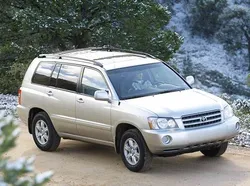

Toyota Highlander Generation - 1 U20 Facelift 2003
Explore the Toyota Highlander Generation 1 U20 Facelift 2003, featuring invaluable insights and specifications. Discover how this model stands out in the automotive landscape.
The Toyota Highlander, introduced in 2000, marked the brand's first foray into the midsize SUV market. The first generation, known as the U20, quickly garnered attention for its combination o...
Technical Specifications
Select Version
Dimensions
Engine
Driving
Others
History and Features
Mycarro AI
Apr 27, 2025
The Toyota Highlander, introduced in 2000, marked the brand's first foray into the midsize SUV market. The first generation, known as the U20, quickly garnered attention for its combination of comfort, practicality, and Toyota's renowned reliability. In 2003, the Highlander underwent a facelift, showcasing an array of enhancements that further solidified its position in the competitive automotive landscape.
Engine and Performance
Under the hood of the 2003 Toyota Highlander, buyers had a choice between two reliable powertrains. The base model came equipped with a 2.4-liter four-cylinder engine, producing 157 horsepower, which provided decent performance for everyday driving. However, for those seeking more power, the available 3.0-liter V6 engine was the preferred option. Delivering 220 horsepower and 222 lb-ft of torque, it offered a more robust driving experience, especially when fully loaded.
The 2003 facelift emphasized enhanced performance with improved transmission options. The V6 model was paired with a five-speed automatic transmission that facilitated smooth gear changes and better fuel efficiency. All-wheel drive was also made available, giving drivers added confidence and stability during inclement weather or off-road adventures, a feature that appealed to families and outdoor enthusiasts alike.
Exterior Design
The 2003 facelift brought a redesign that refreshed the Highlander's exterior aesthetics. The front end was updated with a bolder grille, incorporating a sleeker design that gave the vehicle a more modern appearance. The headlights were elongated and reshaped, contributing to the car’s distinctive look and enhancing visibility. A new line running along the sides helped to modernize the overall profile, while the rear design was refined with updated taillights, providing a more cohesive and sophisticated silhouette.
Additionally, the facelift updated exterior features such as available fog lights and new color options, which helped buyers personalize their Highlander. The changes were subtle yet significant enough to maintain relevance in a fast-changing SUV segment, portraying the Highlander as a stylish and family-friendly option.
Interior Comfort and Features
Inside the 2003 Toyota Highlander, the updates continued, significantly enhancing passenger comfort and convenience. The cabin was designed to accommodate up to seven passengers, with ample headroom and legroom in both the front and rear seats. The quality of materials used throughout the interior reflected Toyota's commitment to comfort, featuring plush seating and well-placed controls for user-friendly access.
Moreover, the facelift introduced improved technology features, including an available touchscreen navigation system and premium audio options. Convenience features such as automatic climate control and a rear air conditioning system were also included, focusing on enhancing the overall passenger experience. The choice of interior colors and materials allowed for further customization, appealing to a broad range of consumers.
Safety Features
Safety has always been a priority for the Toyota brand, and the Highlander was no exception. The 2003 facelift brought additional safety features that helped the vehicle earn competitive safety ratings. Standard safety equipment included anti-lock brakes, traction control, and multiple airbags. Furthermore, the Highlander offered a robust set of optional features, such as side-curtain airbags and stability control, showcasing Toyota's commitment to keeping its occupants secure.
The safety enhancements made the 2003 Highlander a family-friendly vehicle, reinforcing its appeal among parents looking for a reliable SUV that provides peace of mind during family road trips and daily commutes.
Market Reception and Legacy
The 2003 facelift of the Toyota Highlander was well-received by both critics and consumers, with many praising its combination of versatility, reliability, and affordability. The enhancements made during the facelift solidified the Highlander's status as a top choice in the midsize SUV market, appealing to a broad audience ranging from families to single professionals.
As the first generation of the Highlander progressed, it laid a strong foundation for Toyota's future SUV models. The Highlander's success planted the seeds for subsequent generations, which continued to evolve while maintaining the core values that made the original Highlander so popular among drivers around the world.
In conclusion, the Toyota Highlander Generation 1 (U20) facelift of 2003 not only modernized its exterior and enhanced performance but also upped the ante in terms of comfort and safety. The Highlander remains a benchmark in the midsize SUV segment, showcasing Toyota's ability to adapt and innovate in a competitive market.
